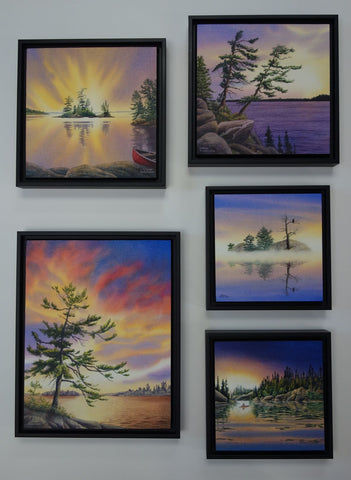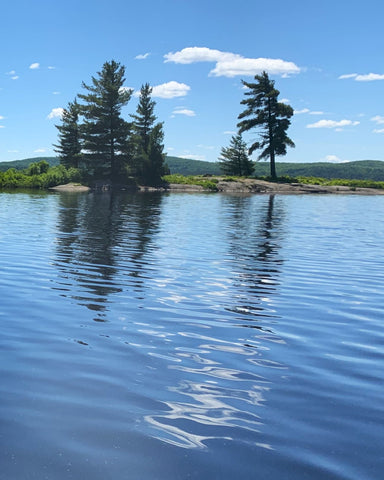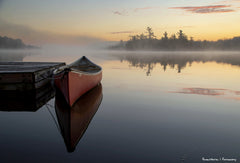
Usually my realistic landscapes begin with a full sized pencil drawing of the entire scene, based on one or more reference photos, before I apply paint to paper.
The five northern lake scenes pictured here were created this spring with a different strategy that pushed me out of my comfort zone of colour and composition.
I began all of the paintings at the same time, using combinations of purple and gold paint mixtures.
Each artwork would have serendipitous focal areas of glowing light. The location of the glow would determine the placement of the scene's horizon.

After taping my watercolour paper to rigid supports, I brushed on clear water and applied a layer of rich colour on each piece of paper, allowing the colours to blend on the wet surface. This photo shows the first layer complete. I let the paintings dry overnight, then re-wet the surface and added more colour.
I continued to add one layer per day, building up more intense colour over the course of a week.
Working on wet paper is very unpredictable and risky, since paint moves freely on the moist surface and I never know how successful my attempts will be until all the layers have dried.
When luck is on my side, this process can result in beautiful glowing skies and lake reflections. If not, I can turn over the paper and try again on the other side. (Been there, done that, many times!)
Once the backgrounds were done, I continued work on the paintings one at a time over a six-week period, completing each artwork before proceeding to the next.
 The largest piece became Nature's Gift, varnished watercolour on 14 x 11 inch panel.
The largest piece became Nature's Gift, varnished watercolour on 14 x 11 inch panel.
The inspiration for the sky was a photo by a Facebook friend, Noreen Ebel Luce, of a sunset on Lake of the Woods. She gave me permission to use her photo (shown here) as a painting idea.

Once I was happy with my many-layered watercolour sky and lake, I invented a pine tree for the foreground (work in progress pictured below left).
I saw that the composition was too heavy on the left side. I needed to either make the tree extend to the right, or add a second tree to the right of the first one. Since watercolour is a transparent medium, I knew I only had one shot at fixing this painting.
To help me decide which option would look better, I took a photo of the artwork in progress and printed out two copies on photocopy paper. Then I used coloured markers to 'test drive' my two ideas (pictured above right).
I liked the single large tree better, so I went with that option to complete the watercolour painting.
For more details about Nature's Gift, click here.

I decided to use the two-tree concept in my next painting, Sunset Duet, varnished watercolour on 10 x 10 inch panel.
This pair of windblown pines pays tribute to the many beautifully sculpted trees I have seen in the Georgian Bay region. These steadfast conifers have spent a lifetime together, adorning this rocky shore. Hand in hand, they sing a quiet farewell to the setting sun.

I gathered several reference photos I had taken at Georgian Bay and sketched out an imaginary lake scene (shown here). With a few modifications, these morphed into a finished sunset painting.
Click here for more information about Sunset Duet.

Something about islands in a calm northern lake just draws me in. I want to hop in a canoe and get a closer look at the rocks and trees that have found a home there.
This idea resulted in the third painting of the series, Heaven on Earth, varnished watercolour on 10 x 10 inch panel.
Searching through my reference archives, I found these three lake photos taken throughout northern Ontario.

Using them as reference, I sketched a composite scene onto my watercolour background, inserting foreground rocks and canoe. Then I painted all the elements in subdued colours to give a feeling of dusky light to the scene.
Click here for more details about Heaven on Earth.

Dawn of a New Day, varnished watercolour on 8 x 8 inch panel, the fourth painting, was taken from my imagination.
Onto my watercolour background I sketched a simple, rocky island and a few trees, with their feet cloaked in a gentle mist.
I made the leafless tree sturdy enough to support a bald eagle, surveying his watery kingdom from a lofty perch. Soft reflections completed the painting.
Click here for more details about Dawn of a New Day.

One Last Look, varnished watercolour on 8 x 8 inch panel was the final painting in the series and the most technically difficult piece.
This scene is Pukaskwa National Park on Lake Superior near Marathon, ON. My husband and I spent a glorious week camping there last summer. Kayaking in Hattie Cove was a special memory of this trip. The surrounding rocky cliffs were so massive and impressive. I didn't want the day to end, and this painting commemorates this special place.


I used these reference photos from our visit, but I took them on a breezy day and my painting had calmer water.
This meant I had to create a whole new set of reflections, based on the physics of how light behaves. I studied a bunch of other reference photos of reflections on waves to understand the concept before completing my painting. I breathed a big sigh of relief when it was done successfully.
For more information about One Last Look, click here.
I hope you have enjoyed this look 'behind the scenes' of what goes on in my art studio. Determining layout concepts and painting approaches are key steps in creating meaningful, beautiful artwork that conveys authentic emotion.
If you have comments you wish to share, please do so using the 'Leave a Comment' button at the top of this post.
Subscribe to Karen's Newsletter for exclusive early access to new work, studio news updates, travel tales, painting tips, and notices of upcoming exhibitions.

























 Listen to the Silence, varnished watercolour on 14 x 11 inch panel.
Listen to the Silence, varnished watercolour on 14 x 11 inch panel.

 Reunion, varnished watercolour on 10 x 10 inch panel.
Reunion, varnished watercolour on 10 x 10 inch panel. For this painting, I used her reference photo (shown here) for the foreground and invented a couple of islands to make a more interesting scene. I changed the canoe colours and decided to make the season autumn, so the trees would complement the canoes.
For this painting, I used her reference photo (shown here) for the foreground and invented a couple of islands to make a more interesting scene. I changed the canoe colours and decided to make the season autumn, so the trees would complement the canoes.

 Some Enchanted Evening, varnished watercolour on 16 x 12 inch panel.
Some Enchanted Evening, varnished watercolour on 16 x 12 inch panel. Maple Flooring, varnished watercolour on 11 x 14 inch panel.
Maple Flooring, varnished watercolour on 11 x 14 inch panel.

























 The largest piece became Nature's Gift, varnished watercolour on 14 x 11 inch panel.
The largest piece became Nature's Gift, varnished watercolour on 14 x 11 inch panel.











 The story began in 2016, when I spotted this pine tree with its top lopped off by a wind storm.
The story began in 2016, when I spotted this pine tree with its top lopped off by a wind storm. That same month, we saw bald eagles quite often during our boat cruises on Lake of the Woods. The eagles would perch on tall trees, looking for their next meal. I managed to photograph this one way up in a dead pine tree.
That same month, we saw bald eagles quite often during our boat cruises on Lake of the Woods. The eagles would perch on tall trees, looking for their next meal. I managed to photograph this one way up in a dead pine tree.



 The marvellous Pebble Beach in the town of Marathon on Lake Superior has inspired yet another painting.
The marvellous Pebble Beach in the town of Marathon on Lake Superior has inspired yet another painting. The scene never looks the same twice, with wind and sunlight affecting the behaviour of the waves and the colours of water and rock.
The scene never looks the same twice, with wind and sunlight affecting the behaviour of the waves and the colours of water and rock. On the subject of multiple interpretations of a given scene, here is my third painting of this northern lake with dock and red canoe.
On the subject of multiple interpretations of a given scene, here is my third painting of this northern lake with dock and red canoe. Thank you to Pamela Weston for permission to use her reference photo (shown here) in the creation of my artwork.
Thank you to Pamela Weston for permission to use her reference photo (shown here) in the creation of my artwork. This photo shows my husband John and me on the left, beside our longtime friends Nancy and Rick, enjoying a bit of snow shoeing at
This photo shows my husband John and me on the left, beside our longtime friends Nancy and Rick, enjoying a bit of snow shoeing at 



 In early March, we went on our second snowmobile adventure, based at
In early March, we went on our second snowmobile adventure, based at  John used a battery powered drill to auger a hole in the ice which was three feet thick. That is me in the camp chair holding a fishing rod over the hole. (No fish were harmed, or even seen, during this escapade!)
John used a battery powered drill to auger a hole in the ice which was three feet thick. That is me in the camp chair holding a fishing rod over the hole. (No fish were harmed, or even seen, during this escapade!)




 I so enjoyed the challenges of this subject that I decided to paint a second version with a different colour palette.
I so enjoyed the challenges of this subject that I decided to paint a second version with a different colour palette.




